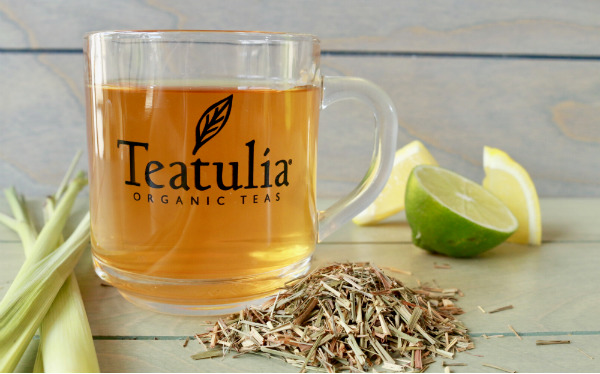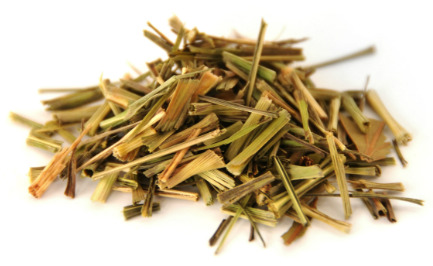Lemongrass (Cymbopogon citratus) is a tall, perennial grass in a class of about 45 species of grasses native to the tropical and sub-tropical climates of Asia, Australia and Africa. India is the highest producer of lemongrass (producing over 2 million pounds per year), where it is cultivated along the mountain range of the Western Ghats and beside the foothills of Arunachal Pradesh and Sikkim in the Himalayan mountains.
Lemongrass grows spectacularly well in Teatulia®’s USDA-certified organic tea garden in Northern Bangladesh, which borders India and is nestled against the Himalayan mountains.
With this native lemongrass, we produce Teatulia’s Lemongrass Herbal Infusion, an invigorating, thirst-quenching herbal blend of lemongrass and bay leaf.
How it Grows
Lemongrass has red base stems and can grow up to 10 feet in its favored habitat. The greatest time of growth for lemongrass is during the summer in moist, rich soil. If youre thinking of planting lemongrass, just remember its roots tend to take over in a garden, so physical barriers should be put up whenever planting the grass near other plants.
Each stalk of lemongrass has several layers, each growing tightly wrapped around its core. The top layers are tough and green like a cornhusk's outer layer. When peeled away, you will find the familiar inner white core of the lemongrass stalk, which best for cooking.
What to Look For
When buying lemongrass, it’s important to keep a few essential facts in mind:
- Look for firm stalks; stalks that are soft or rubbery will not yield good flavor.
- The lower stalk should be a pale yellow, while the upper stalks are green.
- Stay away from lemongrass that has brown outer leaves.
Once you’ve selected your lemongrass, consider these storage tips:
- If you find your stalks have dried out, place them into pots of soil. Within ten days or so, they will grow new, bright-green blades.
- Good-quality lemongrass can be stored in the refrigerator, tightly wrapped, for up to two weeks.
- Lemongrass freezes well. Some of the aroma and freshness may be lost when ifrozen for long periods of time, but the unique flavor will remain and the grass will be easier to cut.
- Lemongrass stalks can also be cut into small pieces and dried. These dried pieces should be stored in airtight jars then used as is or ground to a powder before incorporating into a dish.
Lemongrass Processing: Steaming → Cutting → Withering → Drying
How to Use Lemongrass
In Tea
In African and Latin American cultures, lemongrass is frequently used (fresh or dried) to make tea.
Teatulia’s Lemongrass Herbal Infusion is a delicate blend of lemongrass and bay leaf, both grown in our own USDA-Certified organic tea garden. The bay leaf adds a uniquely invigorating aroma to the citrusy lemongrass, making the drink extremely refreshing when served hot or iced. To prepare our Lemongrass Herbal Infusion, pour 8 ounces of boiling water over one pyramid tea bag or 2 grams of the loose leaf herbal tea, and steep for five minutes.
Because Teatulia’s Lemongrass Herbal Infusion is tisane (also known as herbal tea), it can be left steeping in water indefinitely without the flavor developing the burnt, metallic or bitter taste that black, green or white teas can develop if allowed to steep too long. Tisanes are not made from the leaves of a Camellia sinensis tea plant and therefore do not adhere to the same strict steeping times. Because tisanes do not contain the tea plant, they also do not contain caffeine.
In Food
The lower stalk of the lemongrass is widely used as an herb in cooking in Asian cuisine. Its mild citrus flavor is can be used in soups, poultry, beef and seafood dishes in its fresh, powered or dried format. When cooking with lemongrass, it’s usually best to remove all the outer layers, leaving just the tender white inner stalk. Many recipes call for “bruising” or bending the lemongrass several times to help release the flavor.
At Home
The oil extracted from lemongrass can be used for several different household purposes.
The characteristic bright citrus smell of the oil makes its beneficial for scenting soaps, detergents and insect repellent. The major use of lemongrass oil is as a source of citral, which is a popular ingredient in perfumes, cosmetics and beverages.
Lemongrass oil is most often used as a natural pest repellent in gardens to ward off insects. Despite its ability to repel insects, honeybees are attracted to the pheromones of the oil. This characteristic of the oil can be beneficial when trying to attract and capture swarms of bees. The oil is also used as an insect repellant ingredient in sprays, candles, soaps and aromatherapy. Research studies have shown the oil to have strong anti-bacterial and anti-fungal properties, making it an essential ingredient in household disinfectants.
Lemongrass oil also makes a good preservative. In India it is applied to the ancient palm-leaf manuscripts. The oil injects natural fluidity into the brittle palm leaves and the hydrophobic nature of the oil keeps the manuscripts dry so the text is not lost to decay due to humidity.
Tasting Lemongrass
Teatulia Lemongrass Tea is one of our more popular herbals. It's been described as a full-bodied and creamy with a zesty kick, like biting into a sweet citrus fruit. Refreshing with pure lemon essence and a touch of bay leaf. Naturally caffeine free, our Lemongrass comes in a whole leaf available as loose leaf or in our premium pyramid bags, or fine cut in our standard tea bags.
Ingredients: Lemongrass & Bay Leaf
Dry Leaves: Small lemongrass stalks and bay leaf pieces.
Aroma: A softer and lighter citrus.
Color: Delicate yellow.
Flavor: Refreshing and clean with a lemony sweetness. An invigorating citrus indulgence.

DIY Recipes
There are many ways you can harness the flavor and aroma of lemongrass at home. Here are some of our favorite recipes featuring lemongrass. Enjoy!
Fresh Lemongrass Tea
Courtesy of Foodnetwork.com
Ingredients:
3 stalks fresh lemongrass
Raw sugar, honey or other sweetener
Twists of lemon (optional)
Directions:
In a large teapot, combine the lemongrass with about 6 cups of rapidly boiling, fresh water. Cover the teapot with a thick towel and allow it to steep for 5 to 10 minutes, or until very aromatic. Strain the liquid into a teacup, sweeten and serve with a twist of lemon, if desired.
Lemongrass Bug Spray
Courtesy of Tasty-yummies.com
Ingredients:
2 oz. distilled or boiled water
1 oz. witch hazel or vodka
30 drops lemongrass essential oil
25 drops peppermint essential oil
15 drops tea tree essential oil
1 teaspoon jojoba oil
Directions:
Fill a clean 4 oz. spray bottle fill with the water. Add the witch hazel or vodka, then add about 50 to 75 total drops of your various essential oils. Shake well. Spray onto exposed skin and/or clothing, avoiding eyes and mucous membranes. Reapply every 2 hours, or as needed. Store in a dark bottle, away from heat or sunlight.
Tom Yum Soup
Ingredients:
- 4-6 cups good-tasting chicken stock
- 6 Teatulia Lemongrass Herbal Infusion pyramid tea bags
- 3 kaffir lime leaves (available fresh or frozen at Asian stores)
- 3-4 cloves garlic, minced
- 1-2 red chilies, finely sliced, OR substitute 1/2 to 3/4 tsp. dried crushed chili
- 3 Tbsp. fish sauce (available at all Asian/Chinese food stores and some supermarket chains)
- a generous handful of fresh shiitake mushrooms, sliced thinly
- 12 medium raw shrimp, shells removed
- 1/2 can good-quality coconut milk, OR 1/2 can evaporated milk
- 1 Tbsp. freshly-squeezed lime juice
- 1/3 cup fresh coriander (cilantro), roughly chopped
- optional: 1/2 tsp. sugar
- optional: extra vegetables of your choice (shown here: cherry tomatoes & broccoli
Preparation:
- Pour stock into a deep cooking pot and bring to a boil.
- Add the lemongrass and boil for 1-2 minutes. If using fresh lemongrass, also add the upper stalk pieces for extra flavor.
- Add garlic, chili, lime leaves, and mushrooms. Reduce heat to medium and simmer 1-2 minutes.
- Add the shrimp (plus other vegetables such as cherry tomatoes and broccoli, if using). Simmer 3-4 minutes, or until shrimp is pink and plump.
- Reduce heat to medium-low and add the coconut milk plus fish sauce and lime juice. Stir well to combine and gently simmer until hot. Test the soup for salt and spice, adding more fish sauce instead of salt (I usually add 1 more Tbsp.), or more chili as desired. If too sour, add 1/2 tsp. sugar. If too spicy for your taste or if you'd like it creamier, add more coconut milk. If too salty, add another squeeze of lime juice.
- Serve in bowls with fresh coriander sprinkled over. For an extra hit of flavor, you can also add some Thai chili sauce, either store-bought or the homemade version: Nam Prik Pao Chili Sauce Recipe. ENJOY

Sources:
"Cymbopogon." Wikipedia. Wikimedia Foundation, 17 Oct. 2013. Web. 17 Oct. 2013.
Durand, Faith. "Good Question: What Is Lemongrass?" The Kitchn. N.p., 23 Oct. 2008. Web. 17 Oct. 2013.
"Lemon Grass." Http://www.nhb.gov.in/. National Horticulture Board, n.d. Web. 21 Oct. 2013.
Metz, Karen. "Lemon Grass a Useful Plant – If It Grows Well Here." Daily Republic Lemon Grass a Useful Plant If It Grows Well Here Comments. N.p., 3 Feb. 2013. Web. 17 Oct. 2013.
"Selecting and Storing Lemongrass." SAVEUR.com. N.p., 23 Jan. 2007. Web. 21 Oct. 2013.


